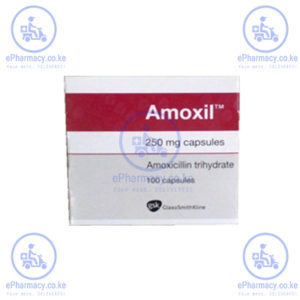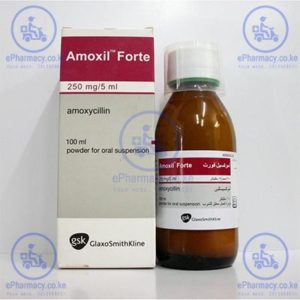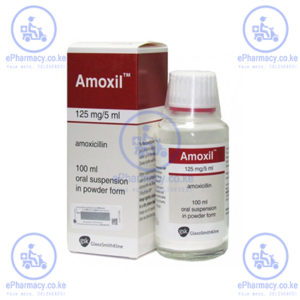Description
Uses and Administration of Amoxicillin in Kenya
Amoxicillin is a Penicillin antibiotic, used in the treatment of susceptible infections in Kenya and the world. It is listed in The WHO Kenya Essential Drugs List as one of the essential drugs. It is used in treating actinomycosis, biliary-tract infections, bronchitis, endocarditis (particularly for prophylaxis), gastro-enteritis (including salmonella enteritis, but not shigellosis), gonorrhoea, Lyme disease, mouth infections, otitis media, pneumonia, spleen disorders (pneumococcal infection prophylaxis), typhoid and paratyphoid fever, and urinary-tract infections. The beta-lactamase inhibitor clavulanic acid widens amoxicillin’s antimicrobial spectrum and a combined preparation (co-amoxiclav/Augmentin) can be used when resistance to amoxicillin is prevalent, for example in respiratory-tract infections due to Haemophilus influenzae or Moraxella catarrhalis (Branhamella catarrhalis), in the empirical treatment of animal bites, or in melioidosis.
Amoxicillin is also given as part of treatment regimens to eradicate of Helicobacter pylori infection in patients in Kenya with peptic ulcer disease. Most common combinations include; Amoxicillin/Clarithromycin/Esomeprazole and Amoxicillin/Clarithromycin/Omeprazole.
Administration and dosage. Amoxicillin is given by mouth as the trihydrate and by injection as the sodium salt. Doses are expressed in terms of the equivalent amount of amoxicillin. 1.06 g of amoxicillin sodium and 1.15 g of amoxicillin trihydrate are each approximately equivalent to 1 g of amoxicillin.
The usual oral dose is 250 to 500 mg every 8 hours, or 500 to 875 mg every 12 hours. Children up to 10 years of age may be given 125 to 250 mg every 8 hours; for those under 40 kg, a dose of 20 to 40 mg/kg daily in divided doses every 8 hours, or 25 to 45 mg/kg daily in divided doses every 12 hours, may be used; in infants less than 3 months old, the maximum dose should be 30 mg/kg daily in divided doses every 12 hours.
Higher oral doses of amoxicillin, either as a single dose or in short courses, are used in some conditions. For example, a dose of 3 g repeated once after 8 hours may be used for dental abscesses. A 3-g dose may be given for uncomplicated acute urinary-tract infections, and repeated once after 10 to 12 hours.
A high-dose regimen of 3 g twice daily may be used in patients with severe or recurrent infections of the respiratory tract. If necessary, children aged 3 to 10 years with otitis media may be given 750 mg twice daily for 2 days. Amoxicillin has also been given as a single dose of 3 g, with probenecid 1 g, in the treatment of uncomplicated gonorrhoea in Kenyan areas where gonococci remain sensitive.
For the prophylaxis of endocarditis in patients at risk, amoxicillin 2 or 3 g is given about 1 hour before dental procedures.
For the eradication of H. pylori in Kenya, amoxicillin is given with either metronidazole or clarithromycin and a proton pump inhibitor or ranitidine bismuth citrate; usual doses of amoxicillin are 0.75 or 1 g twice daily or 500 mg three times daily.
Amoxicillin is administered by intramuscular or slow intravenous injection in doses of 500 mg every 8 hours. In severe infections, 1 g of amoxicillin may be given every 6 hours by slow intravenous injection over 3 to 4 minutes or by infusion over 30 to 60 minutes. Children in Kenya up to 10 years of age may be given 50 to 100 mg/kg daily by injection in divided doses.
Doses may need to be reduced in moderate to severe renal impairment.
Amoxicillin with clavulanic acid. Amoxicillin in combination with clavulanic acid (co-amoxiclav) is given by mouth in a ratio of amoxicillin (as the trihydrate) 2, 4, or 7 parts to 1 part of clavulanic acid (as the potassium salt), or intravenously in a ratio of 5 parts of amoxicillin (as the sodium salt) to 1 part of clavulanic acid (as the potassium salt). Doses of the combination, calculated on amoxicillin content, are similar to those for amoxicillin used alone.
Adverse Effects and Precautions
The incidence of diarrhoea is less with amoxicillin than ampicillin.
Hepatitis and cholestatic jaundice have been reported with the combination amoxicillin with clavulanic acid in Kenya; the clavulanic acid component has been implicated. Erythema multiforme, Stevens-Johnson syndrome, toxic epidermal necrolysis, and exfoliative dermatitis have also been attributed occasionally to the use of amoxicillin with clavulanic acid.





Reviews
There are no reviews yet.